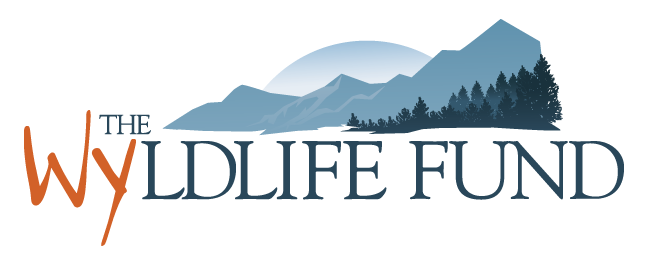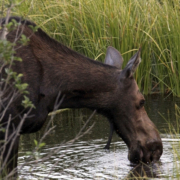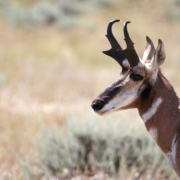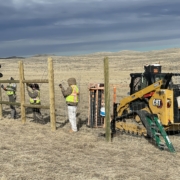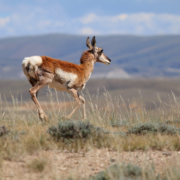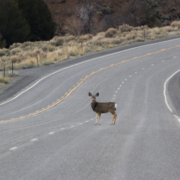Partnership to Conserve Big Game Habitat in Wyoming

December 31st, 2024
The Pooled Migration Fund and USDA-State of Wyoming Big Game Program in Wyoming
2024_Partnership_to_Conserve_Big Game Habitat
As we close out the year, we’d like to take a moment to reflect on the significant progress made for big game conservation in key migration corridors across Wyoming. This achievement is thanks to the USDA-State of Wyoming’s Big Game Program and the support provided by our Pooled Migration Fund (PMF).
In October 2022, USDA Secretary Tom Vilsack and Wyoming Governor Mark Gordon signed an agreement that uses diverse Farm Bill programs and state expertise and resources to support voluntary conservation of private working lands, Tribal lands, and migratory big game populations in Wyoming.
The program emphasizes a commitment to voluntary, incentive-based approaches; identifies and elevates the critical role of private, working lands; and stresses the importance of supporting state, Tribal, and landowners to advance their conservation priorities.

The William and Flora Hewlett Foundation, BAND Foundation, The Volgenau Foundation, Wilburforce Foundation, Bass Pro Shops and Cabela’s Outdoor Fund, Knobloch Family Foundation, NextEra Energy Foundation, and Dominion Energy have all made significant investments to establish and sustain the PMF. The PMF operates under The WYldlife Fund and aims to support and enhance the Big Game Program initiated by the USDA and the State of Wyoming.
The PMF has invested over $1.5 million to directly support the USDA-State of Wyoming Big Game Program. These investments have strengthened critical capacity-building roles with partner NGOs, facilitating connections between producers, Tribal partners, and conservation funding opportunities. Additionally, these funds have been used to implement impactful on-the-ground conservation projects, including invasive annual grass treatments and wildlife-friendly fence modifications.
The WYldlife Fund is excited to report significant progress through this program, with the PMF playing a key role in its successful implementation. Click the link below to learn more about the advancements made for Wyoming’s wildlife.
The Greater Yellowstone Coalition and the WYldlife Fund Partner to Raise $2.7 Million for Wyoming’s Highway 26 Wildlife Crossing Project

The Pooled Migration Fund: A Commitment to Wyoming’s Wildlife
The WYldlife Fund, in partnership with the Wyoming Game and Fish Department (WGFD), is dedicated to the conservation of Wyoming’s wildlife and their habitats. Through the Pooled Migration Fund (PMF), this collaborative effort unites various stakeholders to protect and enhance the migratory habitats of Wyoming’s big game species. By leveraging resources from diverse Farm Bill programs and state expertise, the PMF supports voluntary conservation on private and Tribal lands, fostering a network of conservation efforts across Wyoming.
In 2022, a significant agreement was signed by USDA Secretary Tom Vilsack and Wyoming Governor Mark Gordon, highlighting Wyoming’s leadership in big game migration science and conservation. The PMF seeks proposals from a wide array of partners, including NGOs, state agencies, and land trusts, to expand conservation efforts and increase the impact on migratory habitats.
Earlier this year, The WYldlife Fund Board awarded funding to three pivotal projects, each of which addresses unique conservation challenges and opportunities across Wyoming. Here’s a closer look at these projects:
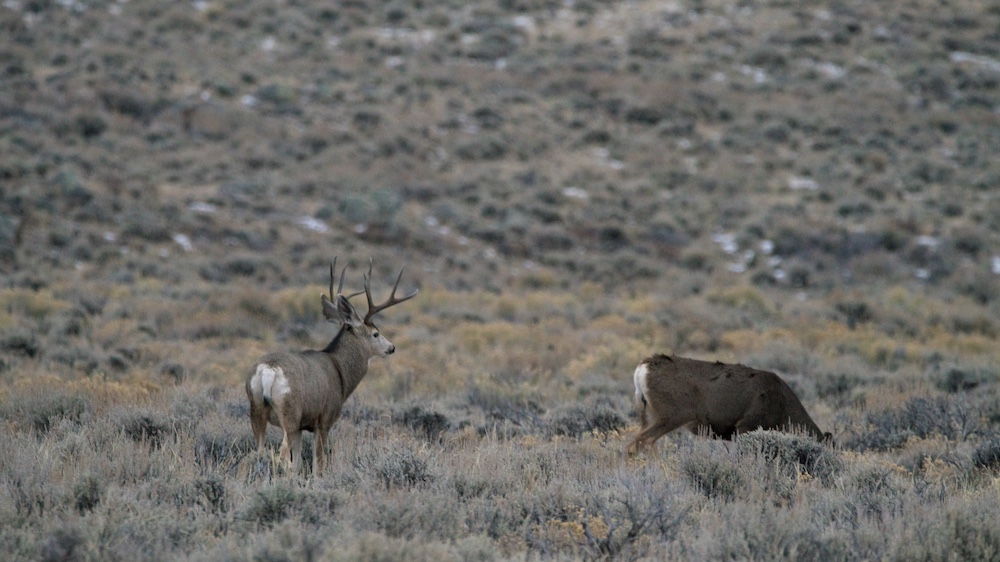
Photo courtesy of the Wyoming Game & Fish Department.
1. Carbon County Weed and Pest
Invasive weeds, particularly cheatgrass, pose a significant threat to native rangelands and wildlife habitats in Carbon County. Cheatgrass outcompetes native plant species, creating dense, monotypic stands that offer little nutritional value to wildlife such as mule deer, pronghorn antelope, bighorn sheep, elk, and sage-grouse.
To address this issue, the Carbon County Weed and Pest (CCWP), in partnership with private, state, and federal entities, has embarked on an extensive project to control and manage cheatgrass proliferation. Through the PMF, The WYldlife Fund awarded $100,000 to this initiative, which aims to protect and restore crucial wildlife habitats across approximately 8,900 acres of land.
The primary treatment method involves aerially applying Indaziflam (Rejuvra) using rotor-wing aircraft at a rate of 5 ounces per acre. Indaziflam has been shown to provide longer-term control of cheatgrass compared to previous treatments like Imazapic (Plateau), which only offers control for about 2-3 years. This treatment is critical in maintaining the health and diversity of native plant communities, thereby supporting higher-quality wildlife habitats.
To accurately map cheatgrass cover, CCWP uses high-resolution satellite imagery from Planet, coupled with ground-truth data. This collaboration enhances monitoring precision, enabling effective management of cheatgrass proliferation.
Reese Irvine, project supervisor, said in a statement, “Carbon County Weed and Pest is excited to partner withThe WYldlife Fund to treat cheatgrass in the Platte Valley. These treatments are taking place in mule deer migration corridors, crucial winter range, and sage-grouse core areas. With the support from The WYldlife Fund, we will be able to treat an additional 1,458 acres of these crucial habitats!”
CCWP and its partners are committed to the long-term success of this project. Continuous monitoring efforts will ensure that if infestations are identified outside previously treated areas, new treatments can be implemented to protect past efforts and further improve habitat conditions. This adaptive management approach ensures that the project can respond dynamically to emerging challenges and opportunities, enhancing its overall impact on the ecosystem.
2. Little Snake River Conservation District
The Little Snake River Conservation District is spearheading a project focused on habitat improvement through juniper removal and shrub treatments. This initiative is part of a long-term effort to enhance the habitat of the Baggs Mule Deer Herd, benefiting mule deer, sage-grouse, and other big game species.
Scheduled for 2024, the project will involve mechanical treatments to remove juniper trees and improve aspen and mixed mountain shrub habitats across 1,200 acres. These treatments will create diverse age classes and species, providing nutritious forage and reducing the risk of catastrophic wildfires. The project also aims to improve habitat quality in crucial winter ranges and stopover sites within designated migration corridors.
“Mule deer numbers are down west wide and after the catastrophic winter kill of 2023 in the Baggs Herd unit, the population hit rock bottom,” said Larry Hicks, Natural Resource Coordinator for the Little Snake River Conservation District. “If we are going to restore this iconic herd back to its 20,000-head strong objective, it’s going to require high quality habitat. It is an all hands on deck approach across all land ownership patterns, including private, state, BLM, and USFS administered lands to restore and enhance crucial habitats and maintain critical migration corridors. The WYldlife Fund has joined a comprehensive landscape scale habitat restoration project and is providing significant funding with other partners to accomplish the goals of restoring this iconic mule deer herd back to its prominence as one of the greatest mule deer herds in the west. Without the support of the WYldlife Fund and the other partners, this effort would not be possible.”
The PMF awarded $75,000 to this initiative, which will continue to monitor and treat areas on a five-year basis.
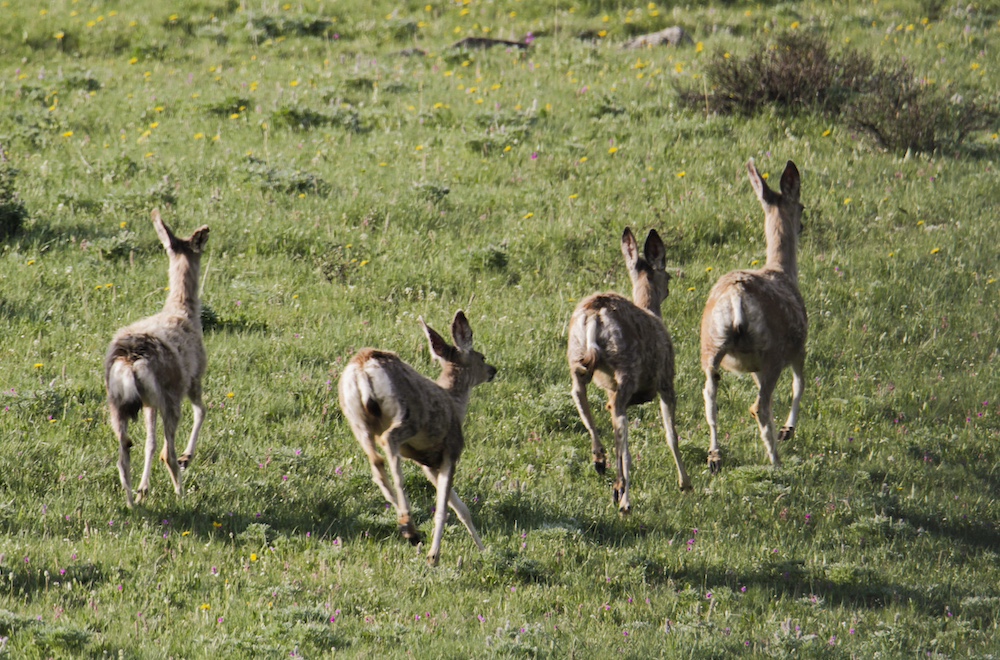
Mule deer in Ten Sleep, June 2017. Photo by Erin Bormett, Wyoming Game & Fish Department.
3. Sublette County Wildlife Friendly Fence Program
Western Wyoming, a stronghold for big game and sage-grouse, faces challenges from landscape fragmentation due to human population growth. One significant barrier to wildlife movement is traditional fencing, which can entangle and injure animals.
To mitigate these risks, the WGFD, in collaboration with local livestock producers, is converting up to 40 miles of fence to wildlife-friendly specifications. These modifications include lowering fence heights, increasing wire spacing, and creating crossing structures that allow safe passage for pronghorn and mule deer. This project, spread over three years (2024-2027), aims to enhance migration corridors and reduce wildlife injuries, contributing to the long-term sustainability of these species.
Of this project, Troy Fiessler, Terrestrial Habitat Biologist with WGFD, said, “While fencing is an essential component of our landscape, it can create severe hazards for wildlife from impeding seasonal migrations to restricting access to key habitats. Located within Sublette County, the Upper Green Fence Initiative strives to provide knowledgeable landowner consultation and more effectively focus implementation of wildlife-friendly fences in areas that provide the greatest benefit to wildlife. With the added support of The WYldlife Fund’s Pooled Migration Funds, our initiative is able to continue mitigating the risks posed by fences through modifications, conversions and removals across dozens of additional miles.”
A total of $75,000 from the PMF was awarded to this project. A well-maintained fence has an expected lifetime of at least 20 years, if not longer. All landowners who participate in this project using PMF funds have agreed to maintain their proposed fences at wildlife-friendly standards for a minimum of 20 years, promising safe passage for wildlife for at least two decades!
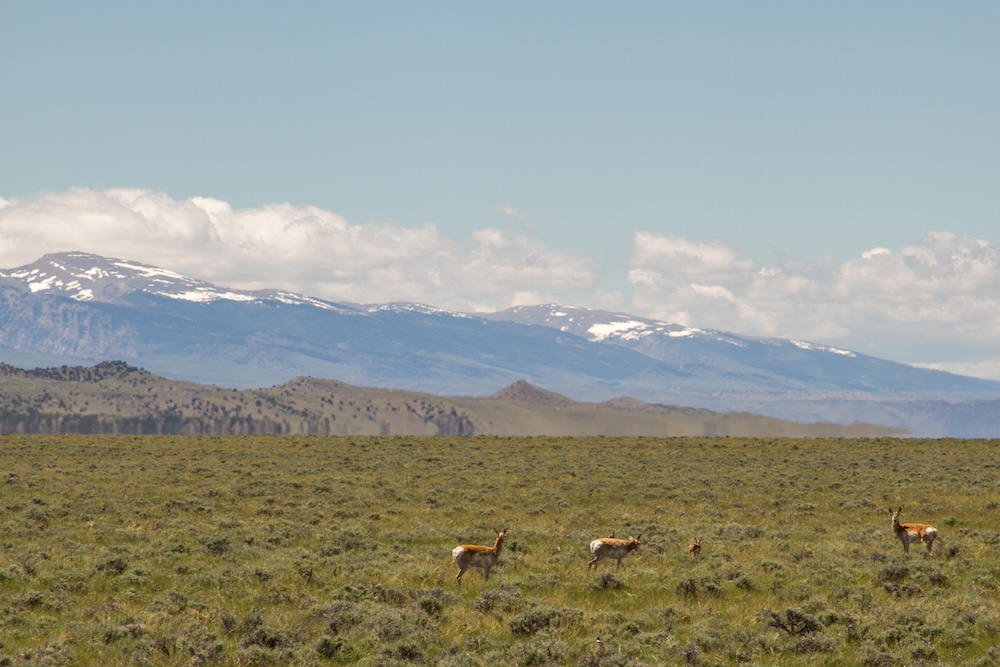
Photo courtesy of the Wyoming Game & Fish Department.
The Pooled Migration Fund exemplifies the power of collaboration in wildlife conservation. By addressing critical challenges like invasive species, habitat degradation, and landscape fragmentation, the PMF-funded projects are making a tangible difference in preserving Wyoming’s rich wildlife heritage. Through continued partnership and innovative solutions, these efforts ensure that Wyoming’s big game populations can thrive for generations to come.
The Moose Fund: A Lifeline for Struggling Moose Populations
In the vast and rugged landscapes of Wyoming, where wildlife thrives amidst stunning natural beauty, moose populations are struggling. These majestic animals are facing challenges that threaten their existence, from habitat loss to warming temperatures. Fortunately, passionate individuals like Mary Rumsey are stepping up to ensure the survival of these iconic creatures through initiatives like The Moose Fund.

Photo courtesy of the Wyoming Game & Fish Department.
The Origins of The Moose Fund
Mary Rumsey, a resident of Meeteetse, Wyoming since 1997, has long held a deep love for moose. Over the decades she’s lived in Meeteetse, she and her neighbors noticed a steady decline in moose numbers. Mary had grown used to seeing them lounging in her front pasture and was comforted by their presence, so it was noticeable when moose started making fewer and fewer appearances. Recognizing the plight of these animals, in 2022 Mary took action by establishing The Moose Fund, a dedicated initiative within The WYldlife Fund aimed at supporting projects and research focused on moose conservation and habitat restoration.
The Moose’s Struggle
Moose are impressively adapted to their northern habitats, with long legs to navigate marshes and deep snow, and dark hair to keep them warm in frigid winters. However, they face significant challenges in warmer climates. All these winter adaptations work against them in the summer months. Moose begin to overheat in temperatures above 56 degrees Fahrenheit, meaning the steadily warming summers have pushed moose tolerance levels to their limits. Wanting to better understand the effects of warming temperatures on moose, the University of Wyoming began a research project in 2020, which was generously funded by Mary and the Wyoming Game & Fish Commission.
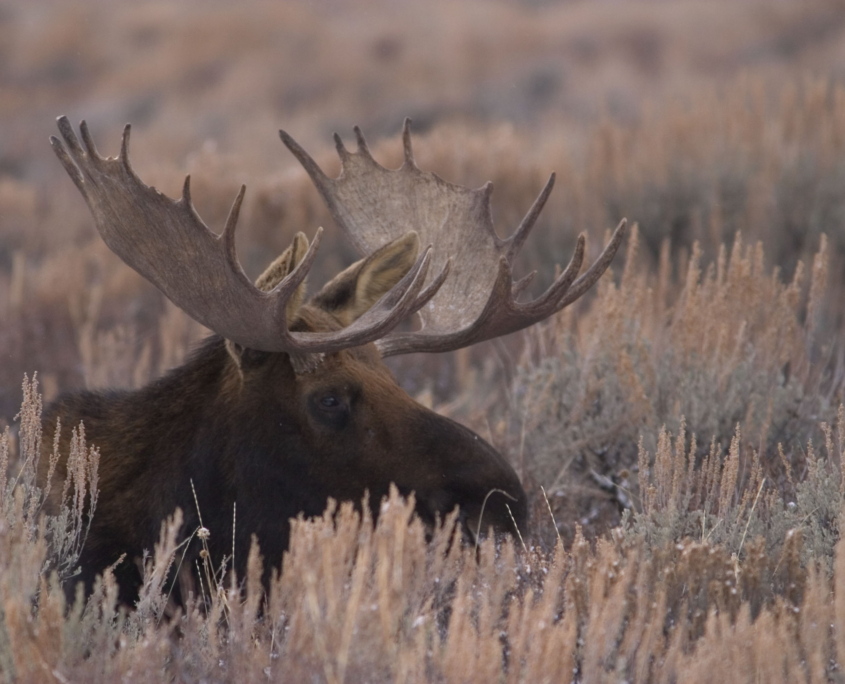
Photo courtesy of the Wyoming Game & Fish Department.
Researchers found that, in trying to stay cool, moose choose water more often than shade. This hefty mammal needs to lay on wet ground or in standing water in order to release potentially life-threatening heat. In the face of a warming, drying climate, this is difficult news.
However, not all hope is lost. The results of this study have created a new goal: to sustain moose populations through the maintenance and improvement of riparian areas such as creek bottoms and wetlands.
The Role of Beavers
Enter: beavers. Interestingly, the fate of moose is intertwined with these large rodents. Beavers, with their remarkable ability to engineer ecosystems through dam-building, create vital riparian habitat that benefits numerous species, including moose. Their dams create pools and wet areas where moose can cool down during hot weather, providing essential relief from heat stress.
Recognizing the connection between beavers and moose habitat, The Moose Fund supported a project to construct a beaver holding facility at the Cody Regional Office of the Wyoming Game and Fish Department in 2023. This facility, completed in late fall of 2023, enables the temporary housing of beavers awaiting translocation, ensuring their well-being and facilitating the restoration of riparian habitats critical for moose survival. Previously, the Cody Regional Office was using a mobile trailer that could only house one beaver family unit at a time, making trapping season slow. The new permanent facility has space for up to four families, allowing for more beavers to be translocated at a time and therefore leading to the creation of more wetland habitats. “This is a very cheap investment for the value of wetland we’re getting out of it,” said Jerry Altermatt, a terrestrial habitat biologist with the Wyoming Game & Fish Department. By relocating beavers to suitable habitats, these efforts not only restore ecosystem functions, but also create essential cooling spots for moose.
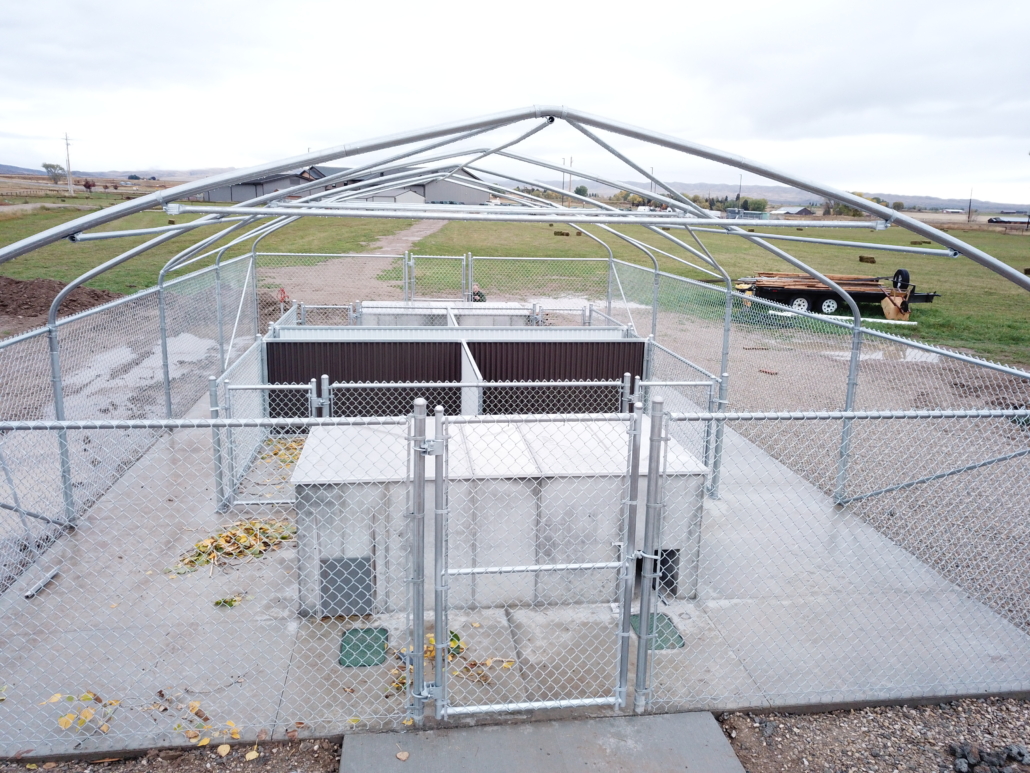
The new beaver holding facility at the Cody Regional Office of the Wyoming Game & Fish Department. Photo courtesy of Jerry Altermatt.

Photo courtesy of Jerry Altermatt.
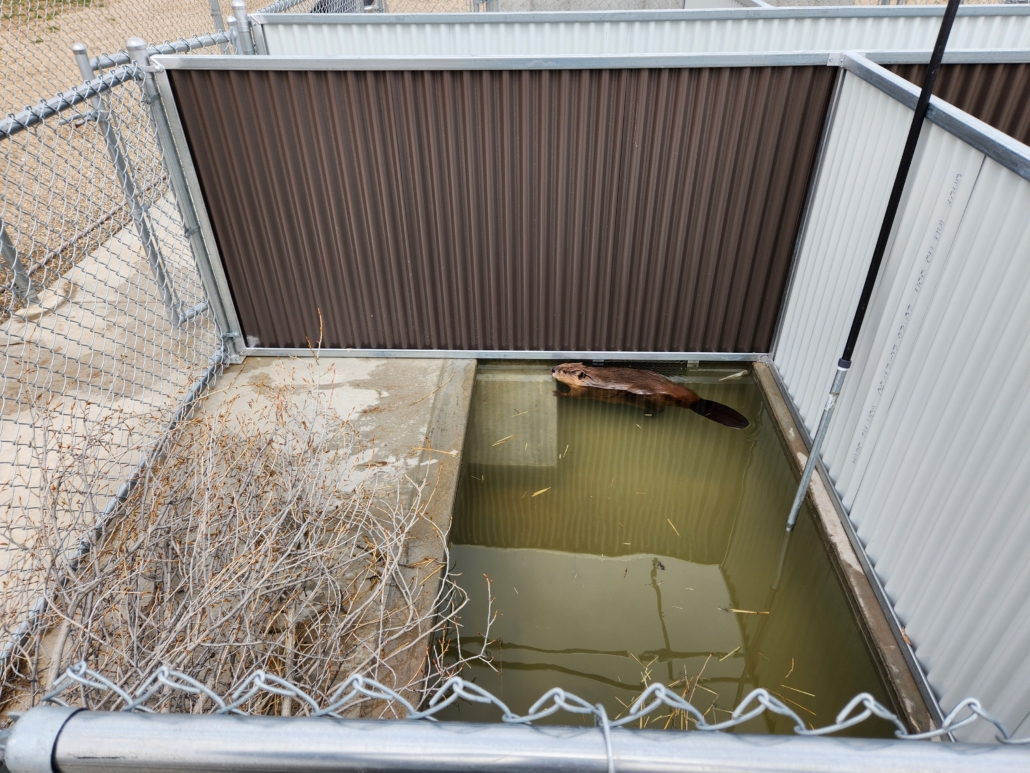
Photo courtesy of Jerry Altermatt.
As a warming, drying climate continues to pose challenges to wildlife, proactive conservation efforts like those supported by The Moose Fund become increasingly important. By investing in projects that address the root causes of habitat degradation and support keystone species like beavers, we can ensure a brighter future for moose and the ecosystems they inhabit.
The Moose Fund stands as a beacon of hope for struggling moose populations in Wyoming and beyond. Through the support of dedicated individuals like Mary Rumsey and collaborative efforts with organizations like the Wyoming Game and Fish Department, we can make a meaningful difference in preserving these iconic creatures and the habitats they rely on. As we continue to champion conservation initiatives, let us remember that by helping beavers, we are also helping moose and the rich tapestry of life that thrives in our wilderness.
If you are interested in making a restricted donation to The Moose Fund, please reach out to The WYldlife Fund at chris@thewyldlifefund.org or 307-316-3863.
Announcing The Pronghorn Fund: Safeguarding Wyoming’s Iconic Wildlife Legacy
Pronghorn, often referred to as the crown jewel of Wyoming’s wildlife, symbolize the state’s unique natural heritage. Their graceful presence has captivated generations, embodying the spirit of the untamed West. Wyoming has the largest intact pronghorn herds in North America. In the wake of the massive winter die-off of 2022-23, coupled with habitat loss and changes brought on by human development, Wyoming’s iconic pronghorn population is struggling. More species-specific research and projects are needed to preserve this iconic population, all of which requires funding.
Rich and Mary Guenzel, long-time Wyoming residents, are eager to provide this funding. They are the generous donors behind the new Pronghorn Fund, a permanently endowed fund within The WYldlife Fund to advance pronghorn habitat, research, and education in Wyoming. With an initial investment of $350,000, investment earnings from this fund will be put to work in the protection of Wyoming’s pronghorn.

Photo courtesy of the Wyoming Game & Fish Department
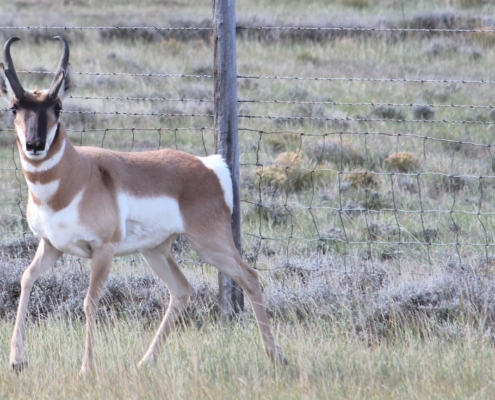
Photo courtesy of the Wyoming Game & Fish Department
This new fund represents a pivotal moment in The WYldlife Fund’s unwavering commitment to wildlife conservation in Wyoming. It serves as a shining example of how individuals can channel their passion for Wyoming’s wildlife into tangible impact through restricted gifts to The WYldlife Fund. The Guenzels’ profound dedication to pronghorn conservation exemplifies this ethos, and we are thrilled to offer them a platform to make a lasting difference in safeguarding this iconic species. Whether you share a passion for pronghorn or any other member of Wyoming’s wildlife, The WYldlife Fund stands ready to collaborate with you in any capacity to contribute to the conservation efforts of your chosen population.
Furthermore, while we recognize and applaud the invaluable efforts of various NGOs across the state dedicated to caring for a number of specific species, The WYldlife Fund now positions itself as a premier organization for those passionate about pronghorn conservation. With the establishment of The Pronghorn Fund, we invite individuals seeking to make a targeted contribution to pronghorn conservation to join us in our mission to protect and preserve these remarkable animals for generations to come.
Last week, we spoke with Rich to learn more about what this species means to him and his wife. “I’d always enjoyed seeing them as a kid,” Rich said. “I grew up in Texas and my parents would take me camping and visiting national parks in Colorado and Wyoming. We would go through the panhandle of Texas and into New Mexico–that was where we’d usually see the first glimpses of pronghorn.” His fascination began there. “The more I learned, the more fascinated by them I became.”
As a young man, Rich moved to Wyoming to attend college at the University of Wyoming, where he studied wildlife biology. He then became a state biologist in the Laramie region, dedicating the next 25 years to the research, conservation, and management of pronghorn, among numerous other species. It was during this time that he met his wife, Mary, who worked as an occupational therapist. They bonded over their shared love of the outdoors and activities like hiking, camping, cross-country skiing, and nature photography. The rest, as they say, is history.
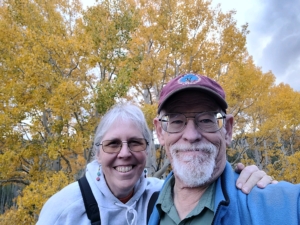
Mary & Rich Guenzel
As a biologist, Rich’s contributions to pronghorn research and management were instrumental in shaping conservation efforts across the region. Now retired, he and Mary want to give back to the species that encapsulates their beloved home state and, more broadly, the West. “There is no better large mammal in Wyoming that exemplifies the character of our state than the pronghorn,” Rich said.
The WYldlife Fund is proud to provide the foundation on which to build The Pronghorn Fund. This fund represents a new chapter in The WYldlife Fund’s commitment to conservation in Wyoming. It will prioritize investments in key areas critical to pronghorn conservation. These include:
-
- Habitat Restoration: Supporting initiatives to restore and conserve pronghorn habitats, particularly their winter ranges. Recent findings from Hall Sawyer and Andrew Telander highlight the pressing issue of unavailable pronghorn habitat in the Red Desert, with an estimated 104,000 acres rendered inaccessible due to exclusionary/woven wire fencing (Sawyer & Telander, 2024). The Pronghorn Fund offers an immediate opportunity to address this critical habitat loss and provide essential support to pronghorn populations devastated by last winter’s challenges.
-
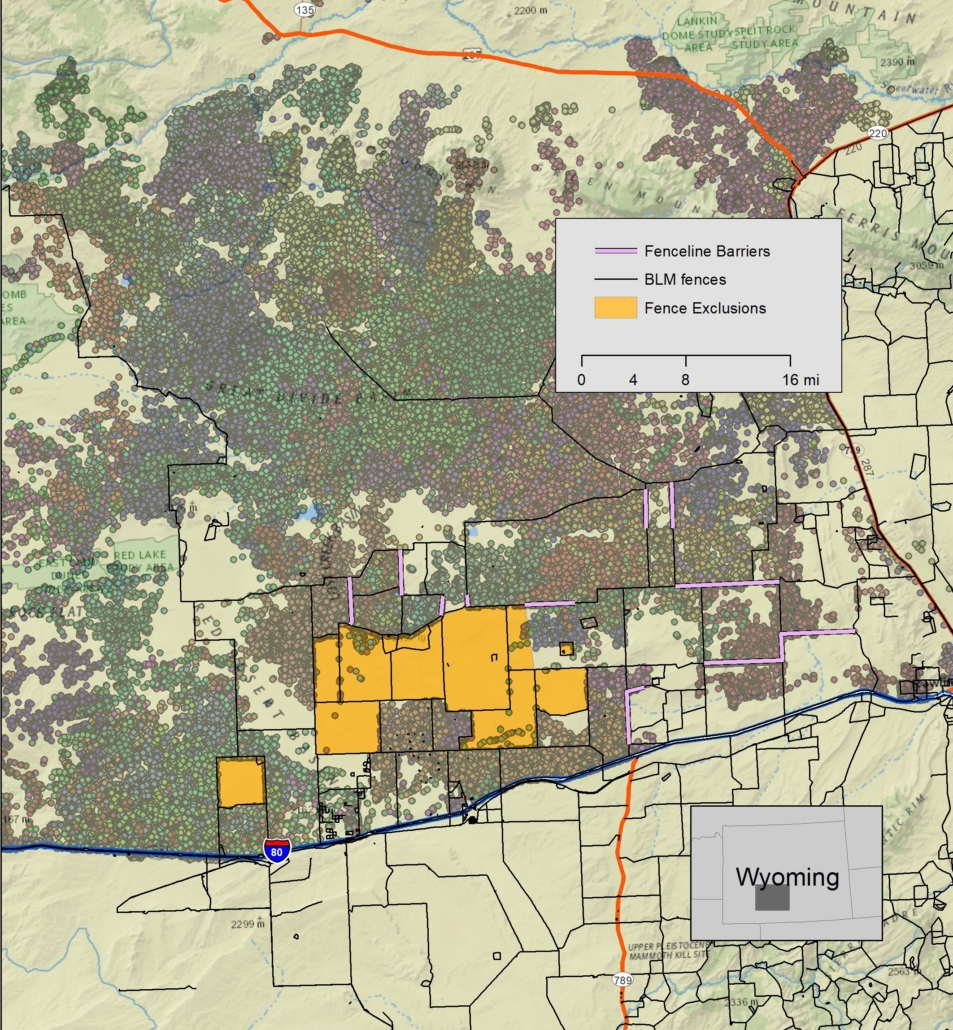
Fence exclusion areas in the Red Desert (Sawyer & Telander, 2024)
- Migration Protection: Contributing to the establishment and maintenance of wildlife corridors to help pronghorn migrate safely across their habitat. This includes land protection, wildlife-friendly fencing solutions, and wildlife crossings and underpasses.
- Scientific Research: Funding research projects aimed at better understanding pronghorn behavior, habitat needs, and the threats they face.
- Education and Outreach: Developing educational programs to raise awareness about the importance of pronghorn conservation and the delicate balance of Wyoming’s ecosystems.
- Community Engagement: Collaborating with local communities to implement conservation initiatives and foster stewardship of pronghorn habitats.
As stewards of Wyoming’s natural heritage, the establishment of The Pronghorn Fund represents a milestone in our collective commitment to conservation. Through collaboration and innovation, we have the opportunity to ensure that pronghorns continue to roam freely across Wyoming’s landscapes for generations to come. With the support of individuals, organizations, and communities, we can safeguard the future of these iconic creatures and preserve the wild spirit of the West. Together, we embark on a journey to protect Wyoming’s crown jewel—the pronghorn.
If you are interested in making a direct gift, or learning more about naming The Pronghorn Fund in your estate planning, please reach out to Chris McBarnes at 307-316-3863 or chris@thewyldlifefund.org.
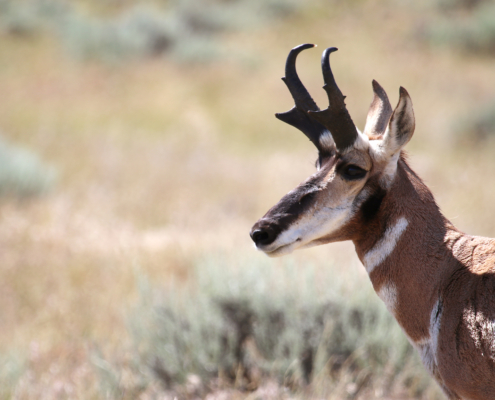
Photo courtesy of the Wyoming Game & Fish Department
Works Cited:
Sawyer, H., & Telander, A. (2024). Lander Region/Red Desert Pronghorn Study. Laramie: Western Ecosystems Technology, Inc.
I-25 Kaycee to Buffalo Wildlife Crossing
The WYldlife Fund (The Fund) embarked on its inaugural large-scale project, the I-25 Kaycee to Buffalo Wildlife Crossing Project, with a remarkable contribution exceeding $350,000. We are elated to share that the project has reached the impressive milestone of 60% completion, with an anticipated finish by fall of this year. Getting to see a project from beginning to end is hugely rewarding for us, and we can’t wait to see the benefits this project brings to wildlife populations, especially to local mule deer herds.
Now, let’s delve into the backstory of this significant endeavor:
In 2014, during public meetings of the Wyoming Game and Fish Department (WGFD) Mule Deer Initiative, concerns regarding the Powder River Mule Deer Herd’s population were voiced. The population had fallen below the objective of 18,000 animals since the early 2000s.
Hunters also noticed a decline in mule deer numbers, resulting in diminished hunting opportunities. Factors such as disease, habitat loss, and highway and transportation infrastructure contributed to this decline.
A specific section of I-25 near Kaycee (mileposts 255-270) was identified as having the second-highest rate of deer collisions on a Wyoming interstate, impeding the safe movement of mule deer seeking additional habitat. This project emerged as a Top 10 Statewide highway crossing priority during the Wyoming Wildlife and Roadways Summit in 2017.
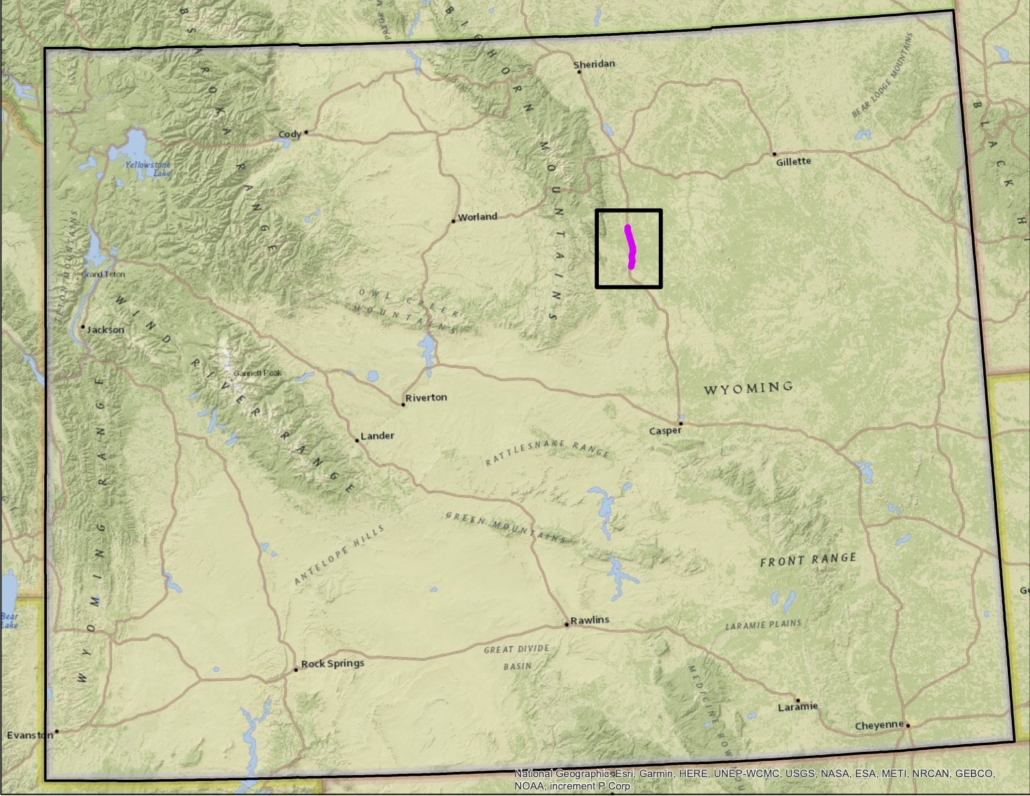
Map highlighting (in pink) the section of highway where the crossing is being constructed.
Statewide, over 6,000 animals, including deer, pronghorn, elk, moose, bighorn sheep, and mountain goats, succumb to wildlife-vehicle collisions (WVCs) each year. The I-25 Kaycee to Buffalo Wildlife Crossing Project aims to mitigate these collisions by facilitating safe passage for wildlife and reducing overall WVC numbers. The project employs exclusionary fencing to guide wildlife to six existing crossing structures, including underpasses, bridges, and culverts. Additionally, deer ramps, gates, and cattle guards are being installed as needed.
The project entails constructing 36 miles of fencing (18 miles on each side of the interstate), requiring 10,000 wooden posts. An intriguing fact—168,000 hog rings, installed by hand, are needed to attach fencing material to the wooden posts. Jumpouts, like the one seen below within the project, are gradual ramps which help wildlife escape the highway corridor should they somehow become trapped.
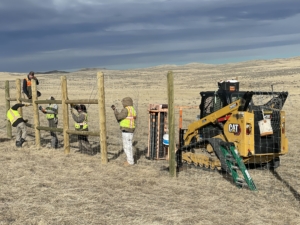
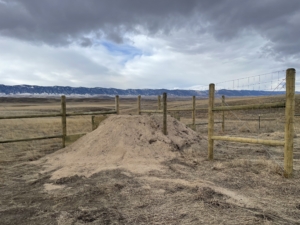
The new fencing directs animals to crossing structures, ensuring safe passage for wildlife and enhancing the safety of interstate travelers. Wyoming currently witnesses 21 big-game collisions daily, with eight involving significant vehicle damage and/or human injury. WVCs cost the state approximately $55 million annually. This project aims to reduce these numbers, safeguarding wildlife, humans, and the state’s budget.
The Fund has diligently monitored existing underpasses with trail cameras since the project’s initiation, capturing numerous mule deer and other charismatic species utilizing them for safe passage across the interstate.
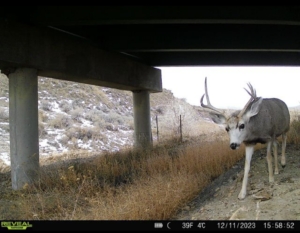
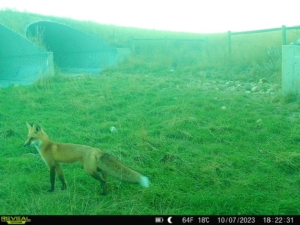
This impactful project owes its existence to the generous support of our sponsors. We extend heartfelt gratitude to the Bass Pro Shops and Cabela’s Outdoor Fund, Golf For Wildlife Outing Supporters, Knobloch Family Foundation, Muley Fanatic Foundation, Williams Energy, Wyoming Wildlife and Natural Resource Trust, Wyoming Department of Transportation and Commission, and Wyoming Game and Fish Department and Commission for making this endeavor possible.
2023 Microgrant Recipients
The WYldlife Fund recognizes that not every important project in Wyoming requires a check for hundreds of thousands of dollars. In this light, we also seek to fund smaller yet impactful projects and initiatives for the good of Wyoming’s wildlife.
Every year, The WYldlife Fund awards microgrants to 501(c)3 organizations working to advance Wyoming’s wildlife, as well as to the Wyoming Game & Fish Department, our partners in numerous wildlife conservation projects. Our Microgrants Program awards up to $2,500 to specific projects. To apply for a grant, organizations in need must submit an application describing the project and its funding needs and budget, the perceived outcomes of the project, the project’s timeline, and a list of other partners. All applications are reviewed by our Microgrants Committee and then recommended to the full Board of Directors for final approval.
In 2023, we funded nine incredible projects. We’re so proud of the work these organizations are doing all throughout the state. Read on to learn more about these projects; perhaps you’ve heard of a few of them yourself!
Jackson Hole Wildlife Foundation – Bear Wise JH
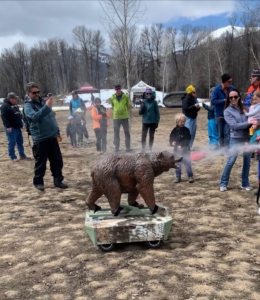
Photo courtesy of JHWF.
The Jackson Hole Wildlife Foundation has a program called Bear Wise JH, which is an education and outreach campaign in Teton County, WY that aims to reduce bear conflicts and promote safety in bear country. Every year, they offer charging bear demonstrations, which closely simulate what it is like to be charged by an aggressive or defensive bear. Participants even get to practice using (empty!) bear spray canisters. Given bear spray’s efficacy at reducing bear conflicts (over 90% effective!) and Teton County’s proximity to bear country, these demonstrations are crucial to all residents and visitors of the area. In 2022, the Bear Wise JH program reached over 5,000 people, and an additional charging bear demonstration has the potential to reach even more people. Last year, the WYldlife Fund was thrilled to present JHWF with a $2,500 microgrant for the construction of a second demonstration, which allowed for the expansion of the popular Bear Wise JH program.
Wyoming Game & Fish Department
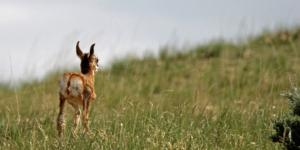
Photo courtesy of WGFD.
We awarded numerous microgrants to the Wyoming Game and Fish Department (WGFD). First, we awarded $2,100 to fund a study on the effects of expandable GPS collars on pronghorn fawns. In particular, researchers are evaluating collared fawns for signs of increased stress levels compared to uncollared fawns. This is done by measuring cortisol levels in collected feces, and given the number of fecal samples, this is an expensive analysis that requires external funding. GPS collars are a common tool used to study population dynamics, land usage, preferred habitat, migration patterns, and more in wildlife populations. The results of this research will be used to inform wildlife biologists and managers conducting research on free-ranging pronghorn, improving our understanding of the species and being better-equipped to manage and conserve their population throughout the state.
Second, we awarded $2,500 to fund WGFD’s Wyoming Women’s Outdoor Series, a once-a-month series of outdoor-focused learning events for up to 25 women in the Laramie area, from January to May. Women learned how to ice fish, clean a rifle, and process food (preparing game meat, canning), as well as learned the basics of OnX Maps and Wilderness First Aid. This was a pilot program that ideally can be brought to other cities in Wyoming. The WYldlife Fund was excited to award this grant and help more women build important outdoor skills.
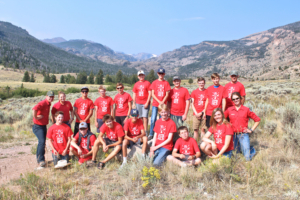
Photo courtesy of WGFD.
Finally, we awarded $2,500 to WGFD’s Whiskey Mountain Conservation Camp in Dubois, WY. This camp hosts eight summer sessions that educate participants about Wyoming’s wildlife and the conservation work being done throughout the state, and that engage participants in outdoor recreation, specifically hunting and fishing. The camp includes five family-focused sessions, two youth sessions, and one session for educators from across Wyoming. In 2022, the camp reached 122 people and has the capacity to grow. We were eager to award funding to the camp to promote to a wider audience and provide high-quality branded swag to participants to raise the camp’s profile throughout the state.
Laramie County 4H Shooting Sports Program
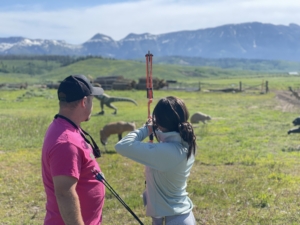
Photo by The WYldlife Fund.
The Laramie County 4H Shooting Sports Program (LCSS) is a partner of The WYldlife Fund and Little Jennie Ranch during our Inspire a Kid (IAK) Camps. Through their Archery Program, LCSS provides top-notch, hands-on archery instruction to all kids attending our IAK camps. Additionally, LCSS offers this same instruction to youth within Laramie County. We were eager to provide $2,500 to LCSS to purchase additional archery equipment to further expand this program.
Cheyenne Volunteers
Lions Park, in Cheyenne, WY, is home to Sloan’s Lake, a 29-acre, 13-foot deep lake that serves as a raw water irrigation source for the City of Cheyenne. It also serves as a spot for recreational activities, including fishing. The lake is stocked with a warm-water fish population and is managed by the Wyoming Game and Fish Department. Unfortunately, the lake lacks underwater structures where fish can spawn and aggregate. Local volunteers want to change this by constructing fish accumulating structures, predominantly for black crappie, sunfish, and largemouth bass, using microgrant funding. The WYldlife Fund was pleased to award $1,000 to these volunteers for project implementation–supported by WGFD and the Board of Public Utilities–the necessary funds to move forward with this project.
Wyoming Game Wardens Association
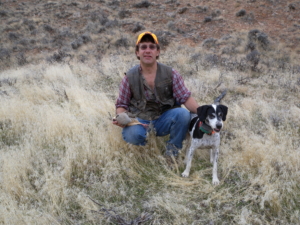
Photo courtesy of the Easterly Family.
The Wyoming Game Wardens Association (WGWA) believes strongly in investing in the youth of Wyoming. In memory of Tom Easterly, a Greybull wildlife biologist who passed away suddenly in 2014, WGWA created a memorial fund which donates lifetime small game and game bird licenses to youth. To increase the available funds, WGWA requested a microgrant of $2,500, and we were proud to contribute to the continuation of the legacy of hunting in Wyoming.
Wyoming Wetlands Society
The Wyoming Wetlands Society (WWS) has been relocating beavers since 2004, live-trapping the animals causing property damage and releasing them in areas where they can restore wetlands away from human conflict. As part of this process, beavers are outfitted with a Passive Integrated Transponder (PIT) tag, which is a minimally invasive tag that is inserted beneath the animal’s skin. Beavers tagged in this way can be identified without recapture, as the tags are read by in-stream PIT tag readers as the animals swim by. WWS requested funding to invest in the necessary equipment to read PIT tags. The WYldlife Fund recognizes the importance this project has to understanding beaver dispersal and habitat restoration, and we were excited to award $2,500 in funding to WWS.
First Hunt Foundation
First Hunt Foundation – WY (FHF-WY) provides programming and mentorship opportunities that emphasize learning lifelong skills as a means to obtain sustainable food sources and self-sufficiency, as well as understand and promote conservation. As FHF-WY continues to grow, there is an increased equipment need for use by participants. Specifically, FHF-WY has seen a growing demand for archery programs. The WYldlife Fund was thrilled to present FHF-WY with $2,500 for the purchase of necessary archery equipment to ensure that there is enough gear for every program participant, furthering FHF-WY’s mission and teachings.
Are you seeking funding for a project that furthers the conservation of Wyoming’s wildlife? Do you know of an organization that could benefit from our microgrants? We are currently accepting applications! Microgrants are administered on a rolling cycle each calendar year. Applications are accepted and evaluated on a first-come, first-served basis until funds available for the calendar year are gone. Head to the link below for more information on how to apply! We can’t wait to see what’s in store for 2024 projects, and we are deeply grateful to all our supporters for making this work possible.
Click here to learn more about the 2024 application process!
WYDOT receives $24.3 million federal grant for Kemmerer wildlife crossing project
We have some exciting news to share in the world of wildlife crossings! But first, a bit of background:
According to Dr. Corinna Riginos of The Nature Conservancy, the annual number of wildlife-vehicle collisions (WVCs) continues to rise over time, with a current five-year average of 7,656 animals per year. The vast majority of these collisions (approx. 5,500) involve mule deer, whose numbers are already in decline. There are currently 21 big-game collisions every day in Wyoming, eight of which involve significant damage to vehicles and/or human injury. The total cost of WVCs in Wyoming average about $55 million per year. These numbers have doubled over the last 15 years, and we can expect them to double again by 2035 if we don’t address the problem. Further, the actual number of collisions and dead animals is likely twice the number that gets counted, due to undetected mortalities away from the roadside.
Since The WYldlife Fund’s inception in 2020, we have made it a top priority to help fund wildlife crossing projects and ensure the safety and survival of wildlife populations most negatively affected by roads. The first large-scale project we helped fully fund was the I-25 Buffalo-to-Kaycee Wildlife Crossing Project. Currently, this project is 90% complete and includes close to 20 miles of big game exclusionary fencing to direct wildlife–mainly mule deer–to existing underpasses.
Earlier this year, The WYldlife Fund began work to raise and pool private funds to support another wildlife crossing project: the HWY-189 South Kemmerer Wildlife Crossing Project.
There is a particular 30-mile stretch along Highway 189 in southwest Wyoming that has seen significant WVCs with pronghorn and mule deer, according to the Wyoming Department of Transportation (WYDOT). These collisions are causing population-level impacts to pronghorn and are disrupting migratory and winter-range movements of mule deer from the Uinta and Wyoming Range Mule Deer Herds. These herds were severely impacted during the harsh 2022-‘23 winter, with biologists reporting upwards of 70% mortality.
This wildlife crossing project would reduce WVCs and promote habitat connectivity for ungulates by directing animals to existing and new wildlife crossing structures. It will also ensure humans can more safely travel this highway, as WVCs are very injurious not only to wildlife, and it will create a plethora of jobs for Wyoming’s workforce. The project is a huge undertaking: to complete it, existing fences will be replaced and five underpasses and one overpass will be constructed. A similar 13-mile-long wildlife crossing project in nearby Nugget Canyon reduced WVCs by 81% while allowing 49,146 mule deer to safely cross the highway during a three-year period, according to Hall Sawyer, Research Biologist at West Inc. We hope to see similar statistics for the Kemmerer project.
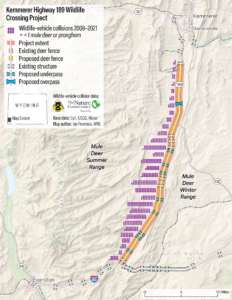
Understandably, a project of this magnitude requires an extensive budget. Together, WYDOT and the Wyoming Game and Fish Department applied for a federal grant through the Wildlife Crossing Pilot Program, which is funded by the Bipartisan Infrastructure Law. The WYldlife Fund helped raise close to $1 million to bolster the federal grant request, which was crucial given the highly competitive nature of the grant process. We also helped garner over 20 support letters for the grant application itself.
The partners who came together through The WYldlife Fund to donate this money are Genesis Alkali Wyoming, the Knobloch Family Foundation, the Mule Deer Foundation, the Muley Fanatic Foundation Blue Ridge Chapter, the Muley Fanatic Foundation Headquarters, the NextEra Energy Foundation, Project West, the Rocky Mountain Power Foundation, SOS Well Services, the supporters of the annual Golf for Wildlife Outing, Spire Storage, TerraPower, The WYldlife Fund, the Wildlife Barrier Breakers Coalition, Williams Energy, and the Wyoming Wildlife Federation. We are beyond grateful for their invaluable support.
Now, for the exciting news we mentioned:
The Federal Highway Administration Award is part of $350 million available through the federal wildlife crossing pilot program. Approximately $112 million was allocated during this first round of awards, with WYDOT receiving more than 20 percent of the available funding for the Kemmerer project–$24.3 million, to be exact!
What’s more, the Wyoming Transportation Commission, Game and Fish Commission, Wyoming Wildlife and Natural Resource Trust, and partners contributed the remaining $8.8 million (which includes private donations to The WYldlife Fund), making the project fully funded!
“I am thankful and excited to have had the opportunity to work with WYDOT, Game and Fish, industry, foundations, and nonprofit organizations to secure this incredibly important funding source to conserve Wyoming’s iconic wildlife,” said Chris McBarnes, President of The WYldlife Fund. “Wyoming is showing the power of public-private partnerships which will continue to produce positive results for wildlife and advance the overall prosperity of our state.”
It has been a very exciting week for all of us, and we are thrilled to be able to share this news with you. Another win for wildlife!
Head here to read the full press release from the Governor’s Office, Game and Fish, and WYDOT!
NextEra Energy Resources Invests in Wyoming Migration Corridors
NextEra Energy Resources Commits $50,000 to The WYldlife Fund in Support of Big Game Migration Corridors
The WYldlife Fund is proud to announce a $50,000 contribution to the Pooled Migration Fund from the NextEra Energy Foundation, the charitable arm of NextEra Energy Resources, to focus on implementing wildlife-friendly projects. The Pooled Migration Fund is dedicated to supporting the United States Department of Agriculture and State of Wyoming’s Big Game Pilot, which aims to conserve big game populations that migrate across working lands in Wyoming via three strategies: land conservation, habitat restoration and long-term private-lands stewardship.
“The WYldlife Fund is grateful for the support from NextEra Energy Resources as it enables us to make significant strides in preserving Wyoming’s exceptional big game species and their migratory corridors,” said WYldlife Fund president Chris McBarnes. “This generous contribution will help us implement projects that will have a lasting positive impact on Wyoming’s wildlife and their ecosystems.”
The Pooled Migration Fund, administered by The WYldlife Fund, is intended to bolster voluntary conservation of private working lands within migration corridors for big game populations in Wyoming. The Pooled Migration Fund supports stewardship of private lands within the recently state-designated Platte Valley, Baggs, and Sublette mule deer migration corridors, as well as multispecies seasonal ranges in the Shoshone River Valleys (i.e. Cody area).
The generous contribution from NextEra Energy Resources will support crucial on-the-ground wildlife projects within these important geographies. These initiatives will play a pivotal role in safeguarding the migratory routes and habitats of the state’s diverse wildlife, ensuring that these invaluable species continue to thrive in their natural environments.
“At NextEra Energy Resources, we are committed to conservation and stewardship of wildlife and their habitats in the states we call home,” said Matt Raffenberg, vice president of environmental services for NextEra Energy Resources. “We are proud to support the Pooled Migration Fund, which aligns with our mission as an industry leader in renewable energy to support sustainable practices and find real-world solutions to address large-scale conservation challenges.”
This donation marks a significant step toward securing a thriving future for Wyoming’s diverse wildlife and their migratory corridors. By working with The WYldlife Fund and supporting habitat improvements, NextEra Energy Resources is helping to ensure that these majestic creatures continue to roam their natural landscapes freely.
